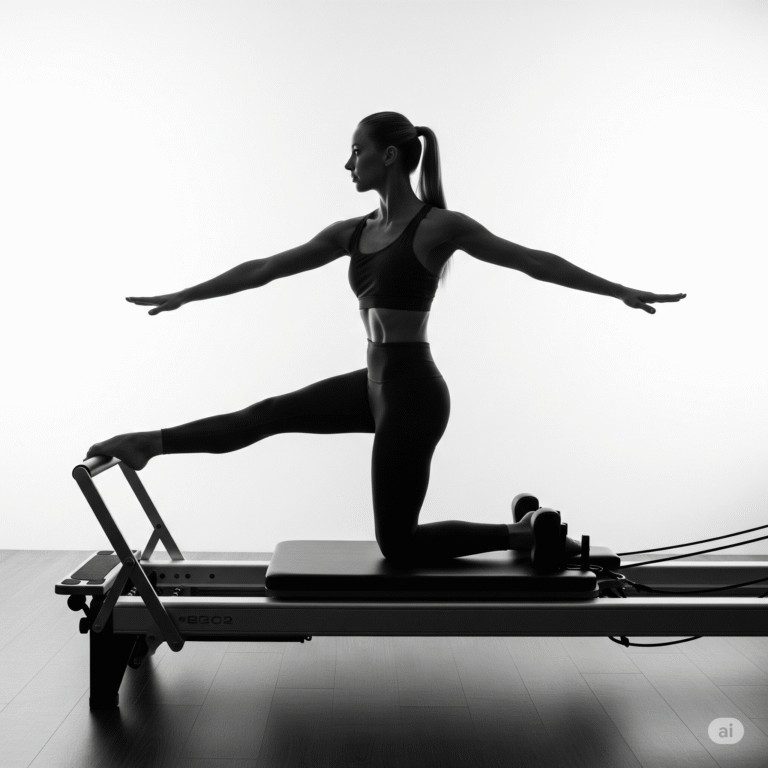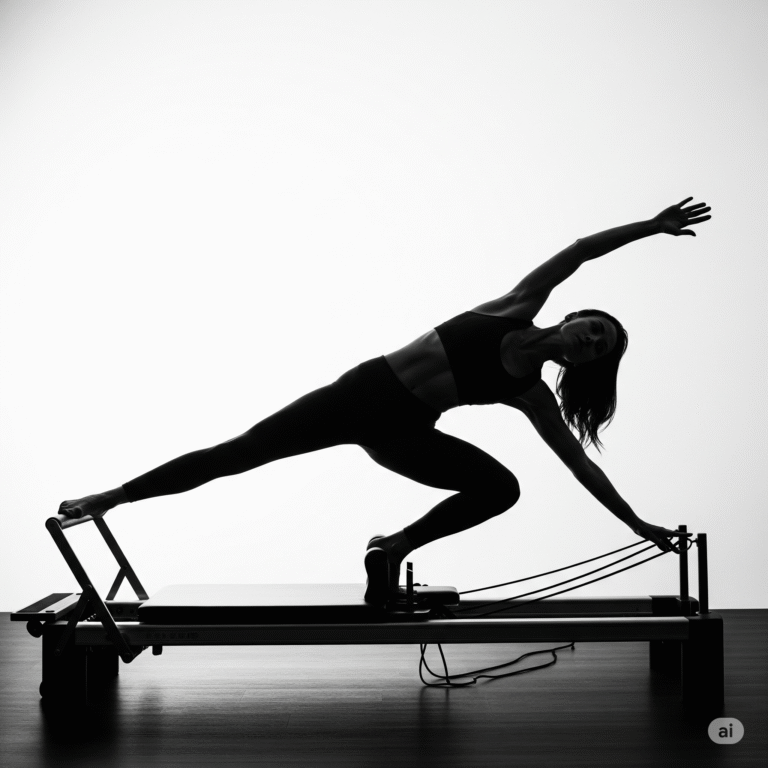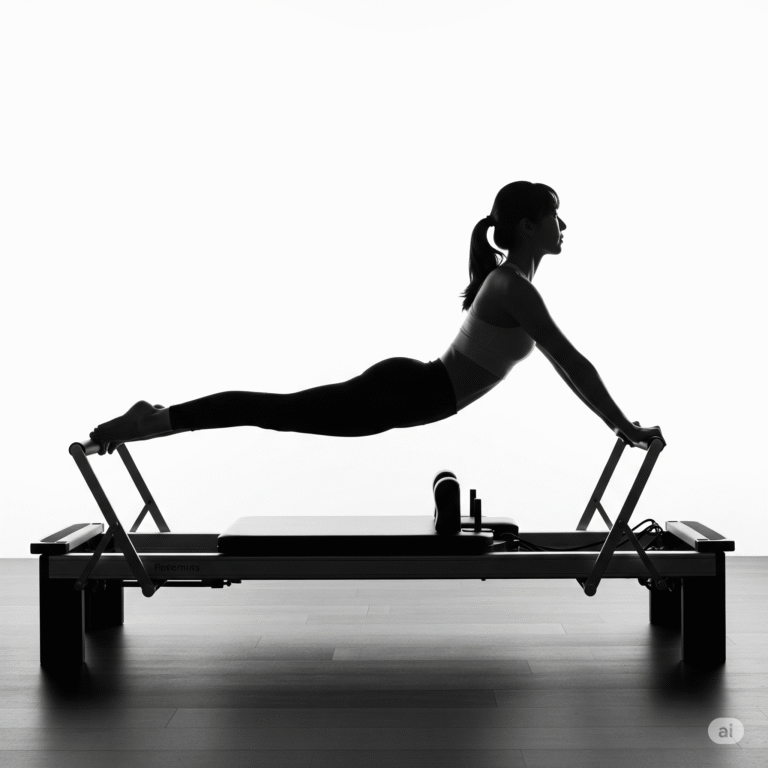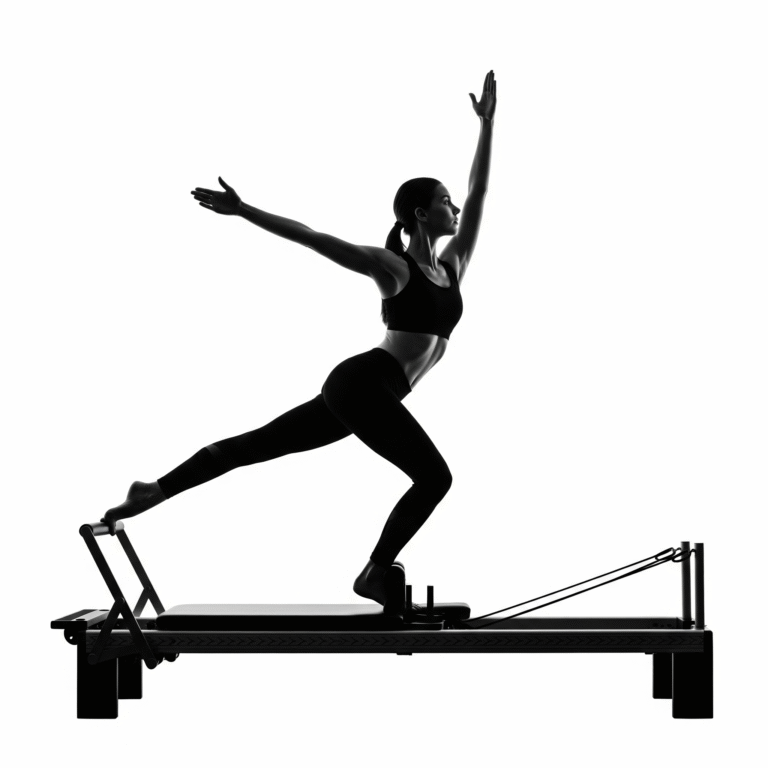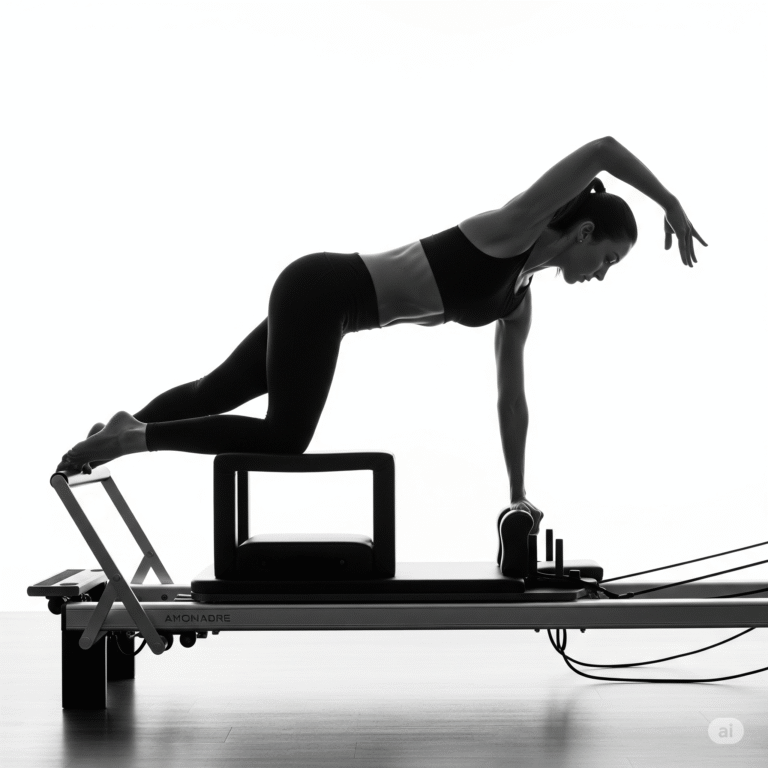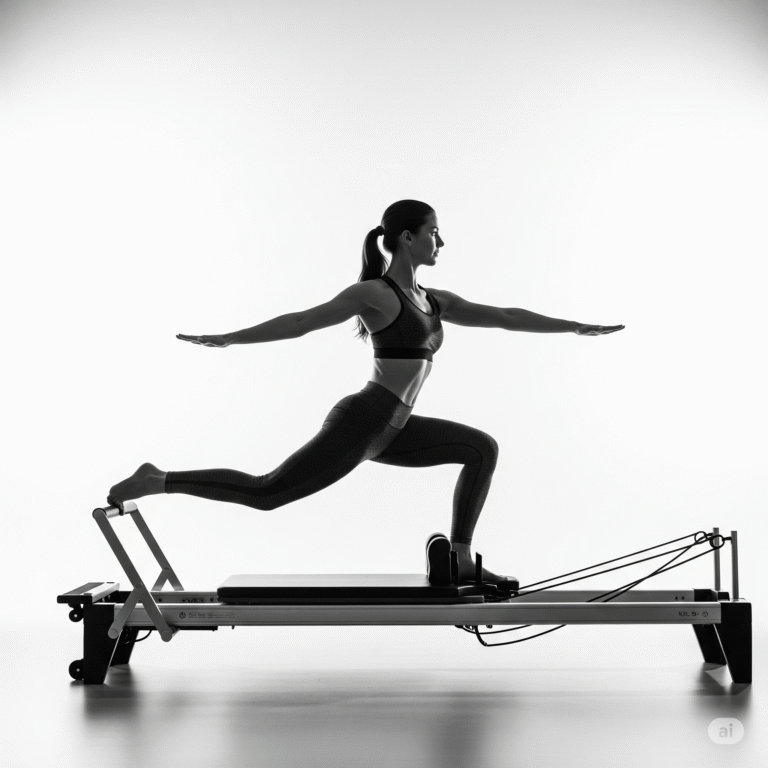Improved Flexibility: Dynamic Movement on the Pilates Reformer
Improved Flexibility: Dynamic Movement on the Pilates Reformer
Flexibility is far more than the ability to touch your toes or perform impressive stretches—it’s a fundamental component of optimal movement and overall health. The Pilates Reformer revolutionizes flexibility training through its unique approach of combining controlled, dynamic movements with variable resistance, creating an environment where flexibility improvements occur naturally and safely.
The Dynamic Difference
Traditional static stretching, where you hold a position for extended periods, has limitations. While it can improve passive flexibility, it doesn’t necessarily translate to improved movement quality or functional flexibility. The Reformer’s approach to flexibility is fundamentally different—it emphasizes dynamic movement patterns that enhance your body’s ability to move through ranges of motion with control and strength.
Dynamic movements on the Reformer challenge muscles to lengthen while simultaneously working, creating what’s known as “active flexibility.” This type of flexibility is far more valuable for daily activities and athletic performance because it teaches your nervous system to control and utilize the full range of motion available to your joints.
Spring-Assisted Lengthening
The Reformer’s spring system provides unique advantages for flexibility development. The springs can assist movements, making it easier to access deeper ranges of motion safely. When performing exercises like the Short Spine or Elephant, the spring tension helps guide your body into optimal positions while providing feedback about proper alignment.
This assisted lengthening is particularly beneficial for individuals with tight hip flexors, hamstrings, or shoulders—common problem areas in our sedentary society. The springs allow you to work into these restrictions gradually, without forcing or straining, which often leads to muscle guarding and potential injury in traditional stretching approaches.
Range of Motion Enhancement
Every Reformer exercise is designed to take joints through their full range of motion in multiple planes of movement. The Footwork series alone moves the hip and knee joints through flexion, extension, and various rotational patterns, while simultaneously challenging the entire kinetic chain from ankles to spine.
This multi-planar approach ensures that flexibility improvements are comprehensive rather than limited to single directions. For example, the Hip Flexor Stretch on the Reformer doesn’t just lengthen the hip flexors in the sagittal plane—it also incorporates lateral and rotational components, addressing the three-dimensional nature of human movement.
Reciprocal Inhibition at Work
The Reformer cleverly utilizes the neurological principle of reciprocal inhibition to enhance flexibility gains. When you actively contract a muscle, its opposing muscle naturally relaxes and lengthens. Many Reformer exercises incorporate this principle, having you actively engage certain muscle groups while simultaneously lengthening their antagonists.
The Long Stretch series exemplifies this concept beautifully. As you push the carriage out while maintaining a plank position, you’re actively engaging your anterior chain (front of the body) while the springs provide gentle traction that encourages lengthening of the posterior chain (back of the body), particularly the spine and hamstrings.
Progressive Flexibility Development
Unlike static stretching routines that can become monotonous and plateau quickly, the Reformer offers endless progression possibilities for flexibility development. You can adjust spring tensions, modify body positions, change the speed of movements, or combine flexibility-focused exercises with strength challenges.
This progressive approach prevents adaptation plateaus and keeps flexibility training engaging and effective. As your mobility improves, the exercises can be modified to continue challenging your body’s limits while maintaining safety and proper form.
Functional Flexibility for Daily Life
The flexibility developed through Reformer training isn’t just about impressive-looking poses—it’s deeply functional. The movements mirror activities of daily living, from reaching overhead to bending down to pick up objects. By improving flexibility through functional movement patterns, you’re enhancing your body’s ability to perform daily tasks with greater ease and reduced risk of injury.
This functional approach to flexibility training is particularly valuable for older adults, desk workers, and anyone dealing with the mobility restrictions that come from repetitive movement patterns or prolonged sitting.
Mind-Body Integration in Flexibility
The controlled, mindful nature of Reformer exercises enhances the mind-body connection essential for lasting flexibility improvements. Unlike aggressive stretching that can trigger protective muscle responses, the Reformer’s approach encourages relaxation and conscious release of tension.
This integration of mental focus with physical movement creates sustainable flexibility gains that extend beyond the studio session, helping you maintain better posture and movement quality throughout your day.
향상된 유연성: 필라테스 리포머의 역동적 움직임
유연성은 발가락을 만지거나 인상적인 스트레칭을 수행하는 능력 이상입니다—그것은 최적의 움직임과 전반적인 건강의 기본 구성 요소입니다. 필라테스 리포머는 제어된 역동적 움직임과 가변 저항을 결합하는 독특한 접근법을 통해 유연성 훈련을 혁신하여, 유연성 향상이 자연스럽고 안전하게 발생하는 환경을 만들어냅니다.
역동적 차이
확장된 기간 동안 자세를 유지하는 전통적인 정적 스트레칭은 한계가 있습니다. 수동적 유연성을 향상시킬 수 있지만, 반드시 향상된 움직임 품질이나 기능적 유연성으로 이어지지는 않습니다. 유연성에 대한 리포머의 접근법은 근본적으로 다릅니다—관절에 사용 가능한 전체 운동 범위를 제어와 근력으로 움직일 수 있는 신체의 능력을 향상시키는 역동적 움직임 패턴을 강조합니다.
리포머의 역동적 움직임은 근육들이 동시에 작업하면서 늘어나도록 도전시켜, “능동적 유연성”으로 알려진 것을 만들어냅니다. 이러한 유형의 유연성은 신경계가 관절에 사용 가능한 전체 운동 범위를 제어하고 활용하도록 가르치기 때문에 일상 활동과 운동 성능에 훨씬 더 가치가 있습니다.
스프링 보조 연장
리포머의 스프링 시스템은 유연성 발달에 독특한 장점을 제공합니다. 스프링은 움직임을 보조하여 더 깊은 운동 범위에 안전하게 접근하기 쉽게 만들 수 있습니다. Short Spine이나 Elephant와 같은 운동을 수행할 때, 스프링 장력은 적절한 정렬에 대한 피드백을 제공하면서 몸을 최적의 위치로 안내하는 데 도움이 됩니다.
이러한 보조된 연장은 특히 좌식 사회에서 흔한 문제 영역인 엉덩이 굴곡근, 햄스트링, 또는 어깨가 긴장된 개인들에게 특히 유익합니다. 스프링은 강제하거나 긴장시키지 않고 이러한 제한들을 점진적으로 해결할 수 있게 해주며, 이는 종종 전통적인 스트레칭 접근법에서 근육 보호와 잠재적 부상으로 이어집니다.
운동 범위 향상
모든 리포머 운동은 여러 움직임 평면에서 관절을 전체 운동 범위를 통해 움직이도록 설계되었습니다. Footwork 시리즈만으로도 발목에서 척추까지의 전체 운동 연쇄에 동시에 도전하면서 엉덩이와 무릎 관절을 굴곡, 신전, 그리고 다양한 회전 패턴을 통해 움직입니다.
이러한 다평면 접근법은 유연성 향상이 단일 방향으로 제한되기보다는 포괄적임을 보장합니다. 예를 들어, 리포머의 Hip Flexor Stretch는 단순히 시상면에서 엉덩이 굴곡근을 늘리는 것이 아닙니다—인간 움직임의 삼차원적 특성을 다루면서 측면과 회전 구성 요소도 포함합니다.
작동하는 상호 억제
리포머는 유연성 향상을 증진하기 위해 상호 억제의 신경학적 원리를 영리하게 활용합니다. 근육을 능동적으로 수축시킬 때, 그 반대 근육은 자연스럽게 이완되고 늘어납니다. 많은 리포머 운동이 이 원리를 포함하여, 특정 근육군을 능동적으로 참여시키면서 동시에 그들의 길항근을 늘리도록 합니다.
Long Stretch 시리즈가 이 개념을 아름답게 예시합니다. 플랭크 자세를 유지하면서 캐리지를 밀어낼 때, 신체 전면(앞쪽)을 능동적으로 참여시키면서 스프링이 후면 연쇄(신체 뒤쪽), 특히 척추와 햄스트링의 연장을 격려하는 부드러운 견인을 제공합니다.
점진적 유연성 발달
빠르게 정체되고 단조로워질 수 있는 정적 스트레칭 루틴과 달리, 리포머는 유연성 발달을 위한 끝없는 진보 가능성을 제공합니다. 스프링 장력을 조절하고, 몸의 위치를 수정하고, 움직임의 속도를 변경하거나, 유연성 중심 운동을 근력 도전과 결합할 수 있습니다.
이러한 점진적 접근법은 적응 정체를 방지하고 유연성 훈련을 흥미롭고 효과적으로 유지합니다. 가동성이 향상됨에 따라 안전성과 적절한 형태를 유지하면서 신체의 한계에 계속 도전하도록 운동을 수정할 수 있습니다.
일상생활을 위한 기능적 유연성
리포머 훈련을 통해 발달된 유연성은 단순히 인상적으로 보이는 자세에 관한 것이 아닙니다—그것은 깊이 기능적입니다. 움직임은 머리 위로 손을 뻗는 것부터 물건을 집기 위해 몸을 굽히는 것까지 일상생활 활동을 반영합니다. 기능적 움직임 패턴을 통해 유연성을 향상시킴으로써, 더 큰 용이함과 감소된 부상 위험으로 일상 과제를 수행하는 신체의 능력을 향상시키고 있습니다.
이러한 유연성 훈련에 대한 기능적 접근법은 특히 노인, 사무직 근로자, 그리고 반복적인 움직임 패턴이나 장시간 앉기에서 오는 가동성 제한을 다루는 모든 사람에게 가치가 있습니다.
유연성에서의 몸-마음 통합
리포머 운동의 제어되고 마음챙김적인 특성은 지속적인 유연성 향상에 필수적인 몸-마음 연결을 향상시킵니다. 보호적 근육 반응을 유발할 수 있는 공격적인 스트레칭과 달리, 리포머의 접근법은 이완과 의식적인 긴장 해제를 격려합니다.
신체적 움직임과 정신적 집중의 이러한 통합은 스튜디오 세션을 넘어 확장되는 지속 가능한 유연성 향상을 만들어내어, 하루 종일 더 나은 자세와 움직임 품질을 유지하는 데 도움이 됩니다.


